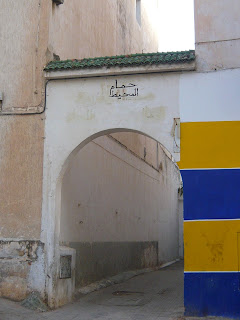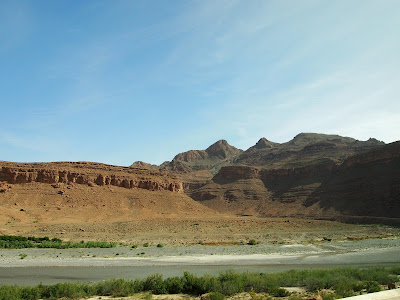普段は日本語でしかブログを更新する余裕がないのですが、今回はモロッコでの最初の1ヶ月間の生活を英語でまとめて英語で書きたいと思います(英語も使わないと忘れちゃうので!)
Then the scenery changed between Ifrane and Midelt, where it reminded me of a village near the French Alps or something.
After passing Midelt, the scenery gradually changed from the mountain ranges covered with snow to rocky mountains with deserts surrounding them.
Then between Midelt and Errachidia, the view reminded me of the Grand Canyons in the US, although I have never been there...
The nature on the way to Goulmima was so beautiful that my coach journey was never boresome...
Goulmima is a beautiful place located at the east of Morocco. It is closer to the Algerian border than to the capital Rabat. In fact it takes 10 hours to travel from Rabat to Goulmima. It is located on the east of Haut Atlas where there are mountain ranges of 4000m in altitude. But the climate there is desert-like temperate dry climate and you can find Goulmima in an oasis in the middle of the dry land like the photo below.
Until now I have not had time to update my blog in both Japanese and English so I have only been writing it in Japanese. I am going to write this post in English to summarise my life in Morocco for the first month. (I apologise for my rusty English in advance as it has been a while since I used it last!)
As most of you may know already, I am now in Morocco as a volunteer of Japan Overseas Cooperation Volunteer (JOCV) programme run by Japan International Cooperation Agency (JICA). I am just about to finish my pre-dispatch training in the capital city of Rabat and from next week I will start working as a rural community development volunteer in a small town called Goulmima.
I arrived in Morocco just one month ago on March 26, 2013.
This was my third time in Morocco after having visited the country twice before at Casablanca and Marrakech with my former job at NGO Peace Boat. I actually fell in love with the counI try when I first visited it with Peace Boat in 2009 and have been wanting to come back since then.
Since I arrived at Rabat, I have been having various orientations at JICA Morocco Office. I started home-staying at a Moroccan family near the city centre of Rabat 3 days after I arrived at the capital.
The family has been really friendly and kind, and although I don't understand almost 100% of their conversations among themselves (because they converse in Darija - the Moroccan Arabic, and they use French when they communicate with me), I enjoyed staying with them. It was a really good opportunity for me to have an insight into the Moroccan culture, cuisine, life-style, religion, customs etc.
In fact, a lot of the Moroccans so far have been really kind and helpful. There are unfortunately some males who are seeking foreign girlfriends and that is part of the reasons that they are kind to foreign females like myself, but for most people that is not the primary reason for helping others.
Before my dispatch to Morocco, I had a 65-day training at one of the JICA training centres in Japan. I was enrolled in intensive French lessons and thanks to the training I am now able to have a basic conversation in French with the Moroccans. However, Morocco's official language is actually Arabic and Berber. French is also widely used in the areas of government administration, education, commerce and so on but for majority of the Moroccans, Darija (Moroccan Arabic) is their native tongue. Therefore, in Rabat, I received another intensive language lessons for 3 weeks, this time, Darija.
Darija lessons were held in French and as you can probably imagine, learning a foreign language in your non-native tongue isn't easy. French is my 3rd language and it is still nowhere near fluent. But in order to communicate with the Darija teacher, French is a must. That's the same for living in Rabat in general if you don't speak Darija. Actually, I feel that learning French is feasible for me because it is similar to English, but I found learning Darija quite difficult. The pronunciation is really different from any other languages that I have learnt in the past and there isn't really a proper 'grammar' in Darija as the teacher explained. Learning a 4th foreign language (Darija) in my 3rd language (French) is the part that I found the most difficult probably in my entire experience here in Rabat but I am sure that it will prove useful when I start working in Goulmima from next week.
In Goulmima, the local people speak Darija and Berber, with probably limited French. One of the former JICA volunteers who worked in the area before me told me that learning Berber is a must if you are working in Goulmima. That means that I will have to learn 5th language in my 3rd or 4th tongue!! I don't know how the hell I am going to cope but to be honest I do enjoy learning foreign languages and cultures, and I have dreamed of participating in this JICA programme for something like almost 3 years, so I am definitely going to make the most out of it.
 |
| Coach station sign written in 4 languages in Errachidia (near Goulmima) - from the top, Arabic, Berber, French and English... |
When I had a weekend trip to Goulmima a few weeks ago, I was absolutely amazed by the beauty and diversity of this country's nature. As the coach travelled from Rabat to Meknes, it reminded me of the green fields in England.
Then the scenery changed between Ifrane and Midelt, where it reminded me of a village near the French Alps or something.
After passing Midelt, the scenery gradually changed from the mountain ranges covered with snow to rocky mountains with deserts surrounding them.
Then between Midelt and Errachidia, the view reminded me of the Grand Canyons in the US, although I have never been there...
The nature on the way to Goulmima was so beautiful that my coach journey was never boresome...
Goulmima is a beautiful place located at the east of Morocco. It is closer to the Algerian border than to the capital Rabat. In fact it takes 10 hours to travel from Rabat to Goulmima. It is located on the east of Haut Atlas where there are mountain ranges of 4000m in altitude. But the climate there is desert-like temperate dry climate and you can find Goulmima in an oasis in the middle of the dry land like the photo below.
 |
| An oasis - Goulmima is the area covered in green in the middle of a dry desert land |
When I first saw the oasis of Goulmima before my eyes, I felt like I finally made it here...! It had been 3 years since I have wanted to come to Morocco as a JICA volunteer, and here I am, standing close to the town where I will be working for 2 years...! I was so happy to see the site but at the same time I felt a little nervous about the life that unfolds ahead for me...
In Goulmima, I was able to meet some women from one of the associations that I will be working, and I was welcomed very warmly by them. Their hand-made crafts were actually really impressive - a lot better than I expected, and that made me wonder what kind of activities that I can facilitate for them... They told me that what they need right now is to expand their sales route in order to increase their income. I am going to spend the first few months exploring what their needs are before deciding what projects I can facilitate with them.
 |
| Typical Berber embroidery - I saw a lot of local women wearing scarves with this pattern in Goulmima |
I am finishing my pre-dispatch training in Rabat this weekend and will leave for Goulmima next Monday. I cannot imagine what kind of life awaits for me there but I am actually looking forward to it.
Until now it has been great to have my fellow JICA volunteers with me whom I have been able to share the experience, feelings, and thoughts - from the start of the training in Japan and also in Rabat. It would be sad to be apart from them when we get dispatched to different regions of the country. But I am really looking forward to be re-united with them a few times a year when we have meetings and orientations etc in the capital and being able to share each other's experience again.








































